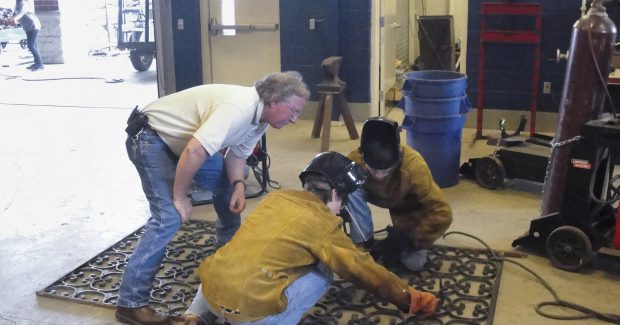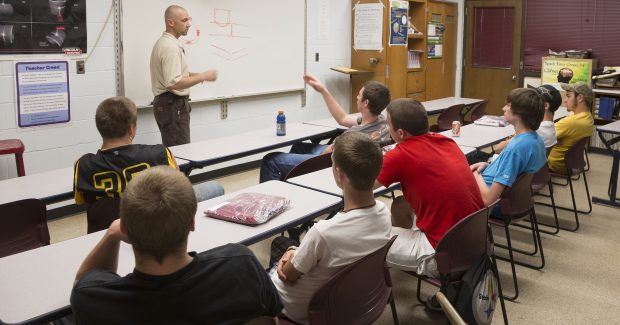Training from the Inside Out
The welding industry is not really facing a skills gap. We’re facing a knowledge gap – and by adopting a new approach to recruitment, screening and training, our industry can bridge this gap and replenish our shop floors with qualified, educated welders.
Posted: December 3, 2014
For the past several years, the manufacturing and industrial sectors repeatedly have raised an alarm regarding the “skills gap,” a shortage of skilled workers needed to fill a number of available advanced manufacturing positions. Welding consistently has come to the forefront of discussions about which trades suffer from this skills gap the most.
The challenge, however, isn’t necessarily the fact that the industry lacks welders. At the end of the day, we have access to plenty of entry-level welders. Those entry-level welders simply don’t have the skills and know-how to match the number of experienced people retiring out of fab shops, plants and job sites.
Simply put, we have not stopped to consider the complexity and diversity of the welding industry today. No two companies’ welding needs are the same, and thus, neither are their staffing requirements. There is a difference between training people to weld and educating someone in welding – they are two distinct ideas. And, the industry today demands an educated person in welding, not so much a classically trained welder.
With this in mind, we need to consider the fact that we’re not facing a skills gap, but instead, a “knowledge gap.” To bridge this gap, manufacturers must ask these important questions:
If we can’t hire experienced workers, how long will it take us to attract these workers and train them and what sort of investment will we have to make to do this?
IMPROVING WELDING’S IMAGE
The welding and fabricating industry needs to examine its educational process and determine if it, and its educational partners, are attracting and teaching the right things to new welders, and taking training to the right level to produce the required class of manufacturing welders.
We can’t solve this problem if we’re waiting for people to go into welding. We must attract talented people to the job. Yes, it’s a frustrating paradigm, but it’s one that must be broken in order to fill the gap and get the people you need in your shops. We need to work together to show what welding and fabricating has to offer.
You won’t bring in the talent you need if job candidates feel that they will be tied to a production table burning rod all day for $12 per hour. The future welding workforce, those hired tomorrow or even next year, must understand welding and its career pathways. Getting future welders to understand this it comes down to improving welding’s image through training and education. You have to be able to demonstrate that a welding career is just that – a career and not a dull, dead-end job.
The first step is to realize that welding schools, such as career technical education centers and college welding programs, are more than just a feeder for basic, entry-level welders. If the industry is saying it can’t get the right people, are we actually going back to the schools to talk with them about what their students need to be learning to fill the knowledge gap, or are we just complaining?
Welding schools are open to discussion both on curriculum and on training people on new technologies from the start. Industry has a responsibility to work with these schools to help them refocus that curriculum to reach beyond basic skills and to help take the appropriate new welders – those that have the aptitude and interest – to the next level before they ever leave school with degrees and certifications in hand.
Today’s fab shops still need basic entry-level workers. But, they also need to attract younger welders with problem-solving skills who understand not only the mechanics of pulling the trigger on a welding gun but also the deeper processes at play behind laying down that bead. We need to work with schools to help develop young welders who understand equipment, consumables and shielding gases so that they enter the workforce with a greater breadth and knowledge of the craft and advancing technology, with an eye on a long, fruitful welding career. And, these future welders need to understand the many benefits offered by the profession.
LOOKING INWARD
To find the right graduates through recruitment and hiring efforts, manufacturers must seriously determine who they need for their workforce. Do you need someone with basic skills? Do you need mid-level welders? Do you need someone with a strong background in welding automation technology or engineering? Or, do you need all three?
For example, if you interview a young welder just out of school who brings both knowledge and potential to the table, this candidate likely isn’t going to be satisfied with a position where he or she stands in the booth, pulling the trigger and burning wire all day if there is no promise for mobility to other levels within your organization. You need to show these new welders that there are pathways to higher-level positions or access to advanced technologies, even if they start with something very basic – which, in fact, most will.
Perhaps you’re looking to hire for a mid-level position and have decided to look only at outside candidates. Perhaps you have a diamond in the rough right there on your shop floor. For instance, you might have some excellent welders in your maintenance department. Don’t overlook your in-house talent pool.
In both of these situations, internal screening and training play immensely important staff-retention and development roles. Manage and guide your young talent to keep them interested in the craft and maintain what you already have invested in them as employees. Remember, you are not starting a welding school to teach future welders from scratch. Instead, you are creating a simple, sustainable professional development program.
To speed up internal training and screening efforts, take a hard look at your worker base. You have “A,” “B” and “C” players. Your A welders will definitely deliver more productivity and better work. That’s not to say you can’t cultivate and grow the abilities of your B and C welders, But, you don’t just train them, you differentiate the instruction to make your “A” team into “A+” players, “B” into “As”, and your “C” players into “Bs”.
An A-level welder may get frustrated in a class with students of other levels. So, too, will a C welder in a class filled with more skilled colleagues. Their knowledge requirements differ, so their learning sessions also should differ – focused on their existing abilities and the skill sets you want them to achieve. Further boost your program’s longevity and sustainability by having “A” players mentor less-skilled members of the team. Grow your talent from the inside out and get everyone involved.
We’re not really facing a skills gap. We’re facing a knowledge gap – and by adopting a new approach to recruitment, screening and training, we as an industry can bridge this gap and replenish our shop floors with qualified, educated welders.
Carl Peters is director of technical training and Jason Scales is a welding education specialist at The Lincoln Electric Company, 22801 Saint Clair Avenue, Cleveland, OH 44117-1199, 216-383-


















